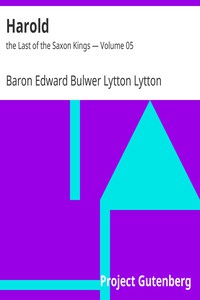Harold : the Last of the Saxon Kings — Complete by Lytton (an ebook reader TXT) 📖

- Author: Lytton
Book online «Harold : the Last of the Saxon Kings — Complete by Lytton (an ebook reader TXT) 📖». Author Lytton
279 (return)
“Rex magnus parva jacet hic Gulielmus in urna— Sufficit et magno parva Domus Domino.”
From William the Conqueror’s epitaph (ap-Gemiticen). His bones are said to have been disinterred some centuries after his death.
280 (return)
Thomson’s Essay on Magna Charta.
281 (return)
Orderic. Vital. lib. 4.
282 (return)
The date of William’s marriage has been variously stated in English and Norman history, but is usually fixed in 1051-2. M. Pluquet, however, in a note to his edition of the “Roman de Rou,” says that the only authority for the date of that marriage is in the Chronicle of Tours, and it is there referred to 1053. It would seem that the Papal excommunication was not actually taken off till 1059; nor the formal dispensation for the marriage granted till 1063.
283 (return)
For authorities for the above sketch, and for many interesting details of Lanfranc’s character, see Orderic. Vital. Hen. de Knyghton, lib. ii. Gervasius; and the life of Lanfranc, to be found in the collection of his Works, etc.
284 (return)
Pigott’s Scand. Mythol. p. 380. Half. Vand. Saga.
285 (return)
“Suthsaxonum Ministrum Wolfnothem.” Flor. Wig.
286 (return)
Asser. de Reb. Gest. Alf. pp. 17, 18.
287 (return)
Camden, Caernarvonshire.
288 (return)
Pennant’s Wales, vol. ii. p. 146.
289 (return)
The ruins still extant are much diminished since the time even of Pownall or Pennant; and must be indeed inconsiderable, compared with the buildings or walls which existed at the date of my tale.
290 (return)
Johann. ap. Acad. Celt. tom. iii. p. 151.
291 (return)
William of Poitiers.
292 (return)
He is considered to refer to such bequest in one of his charters: “Devicto Harlodo rege cum suis complicibus qui michi regnum prudentia Domini destinatum, et beneficio concessionis Domini et cognati mei gloriosi regis Edwardi concessum conati sunt auferre.”—FORESTINA, A. 3.
But William’s word is certainly not to be taken, for he never scrupled to break it; and even in these words he does not state that it was left him by Edward’s will, but destined and given to him—words founded, perhaps, solely on the promise referred to, before Edward came to the throne, corroborated by some messages in the earlier years of his reign, through the Norman Archbishop of Canterbury, who seems to have been a notable intriguer to that end.
293 (return)
Palgrave, “Commonwealth,” 560.
294 (return)
“Quo tumulato, subregulus Haroldus Godwin Ducis filius, quem rex ante suam decessionem regni successorem elegerat, a totius Angliae primatibus, ad regale culmen electus, die eodem ab Aldredo Eboracensi Archiepiscopo in regem est honorifice consecratus.”—FLOR. Wig.
295 (return)
Some of these Norman chroniclers tell an absurd story of Harold’s seizing the crown from the hand of the bishop, and putting it himself on his head. The Bayeux Tapestry, which is William’s most connected apology for his claim, shows no such violence; but Harold is represented as crowned very peaceably. With more art, (as I have observed elsewhere,) the Tapestry represents Stigand as crowning him instead of Alred; Stigand being at that time under the Pope’s interdict.
296 (return)
Edward died Jan. 5th. Harold’s coronation is said to have taken place Jan. the 12th; but there is no very satisfactory evidence as to the precise day; indeed some writers would imply that he was crowned the day after Edward’s death, which is scarcely possible.
297 (return)
Vit. Harold. Chron. Ang. Norm.
299 (return)
This William Mallet was the father
 Have you ever thought about what fiction is? Probably, such a question may seem surprising: and so everything is clear. Every person throughout his life has to repeatedly create the works he needs for specific purposes - statements, autobiographies, dictations - using not gypsum or clay, not musical notes, not paints, but just a word. At the same time, almost every person will be very surprised if he is told that he thereby created a work of fiction, which is very different from visual art, music and sculpture making. However, everyone understands that a student's essay or dictation is fundamentally different from novels, short stories, news that are created by professional writers. In the works of professionals there is the most important difference - excogitation. But, oddly enough, in a school literature course, you don’t realize the full power of fiction. So using our website in your free time discover fiction for yourself.
Have you ever thought about what fiction is? Probably, such a question may seem surprising: and so everything is clear. Every person throughout his life has to repeatedly create the works he needs for specific purposes - statements, autobiographies, dictations - using not gypsum or clay, not musical notes, not paints, but just a word. At the same time, almost every person will be very surprised if he is told that he thereby created a work of fiction, which is very different from visual art, music and sculpture making. However, everyone understands that a student's essay or dictation is fundamentally different from novels, short stories, news that are created by professional writers. In the works of professionals there is the most important difference - excogitation. But, oddly enough, in a school literature course, you don’t realize the full power of fiction. So using our website in your free time discover fiction for yourself. 




Comments (0)